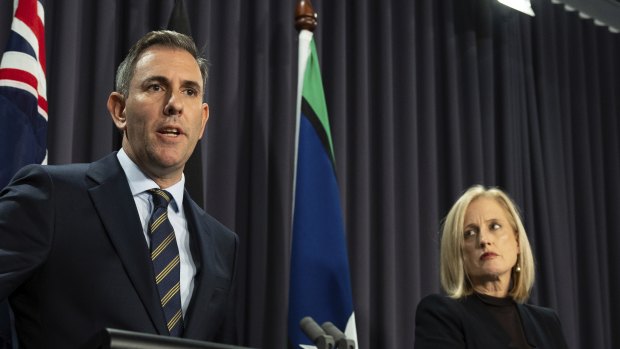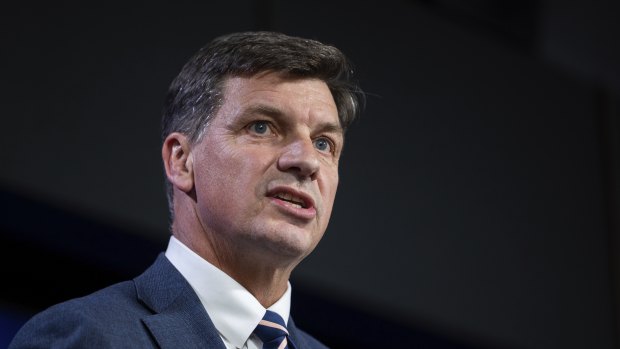This was published 11 months ago
No scorched earth: Chalmers promises budget spending as economy slows
By Shane Wright
Treasurer Jim Chalmers has admitted the economy has slowed more than he expected, while declaring next week’s budget would not adopt a “scorched-earth austerity” approach to bring down inflation.
As the Reserve Bank board prepares to announce whether it will hit home buyers with another interest rate rise on Tuesday, Chalmers pushed back at accusations he was making life more difficult for the bank by running budget deficits over coming years.

Treasurer Jim Chalmers and Finance Minister Katy Gallagher ahead of next week’s federal budget.Credit: Alex Ellinghausen
Despite a $25 billion increase in expected tax revenues over the next four years, Chalmers is expected to announce cumulative budget deficits larger than the $73.4 billion forecast in the mid-year update in December.
The larger deficits will not materially affect the government’s debt level, which is on track to reach $904 billion this financial year, $152 billion lower than had been forecast just ahead of the 2022 election.
While a surplus this financial year is still “within reach”, following the record 2022-23 surplus of $22.1 billion, Chalmers admitted on Monday that extra spending would be contained in the coming budget.
He said the government was making a deliberate choice to support the economy by not slashing expenditure, conceding that overall growth was soft.
“This is not the time for scorched-earth austerity,” he said. “This is not the time to slash and burn in the budget when people are doing it tough and when growth in our economy is weaker than we would like it to be.”
When the national accounts were released in early March, showing economic growth at just 0.2 per cent over the quarter, Chalmers described the result as “subdued but steady”. In per capita terms, however, the economy has been contracting since mid-2023.
Chalmers said next week’s budget would chart a “responsible middle course” that was focused on dealing with inflation in the near term but which supported the economy in coming years.
He rejected suggestions that near-term extra spending in areas such as the government’s planned Future Made in Australia program would add to inflation.
“Another point that is often lost is what matters here is not just the quantity of spending in the budget, but the quality of the spending in the budget, the timing of that spending, the sequencing of that spending,” he said.
The extra spending means while government debt has not reached the levels forecast ahead of the election, it is still on track to increase. As a share of the economy, it is expected to climb from 33.7 per cent this year to 33.9 per cent in 2024-25 and 35.1 per cent in 2025-26.
That suggests extra spending, and the debt needed to finance it, has been pushed into the 2025-26 financial year, for which the government was already forecasting a deficit of $35.1 billion.
Commonwealth Bank chief economist Stephen Halmarick, who is expecting a budget deficit of $5 billion in 2024-25, played down suggestions it would force the Reserve Bank to lift interest rates.
“This would imply that Commonwealth government fiscal policy will be mildly stimulatory for the overall setting of policy, but not enough to have a significant impact on the expected path of monetary policy,” he said.
Finance Minister Katy Gallagher revealed an extra $1 billion in savings from reducing the government’s use of outside consultants, while the Defence Department is expected to reprioritise some of its spending to pay for its new projects.
She said despite looking under “each desk” to find new savings, the government would also have to spend more money on programs that had not been fully funded, such as ongoing palliative care support, or that needed extra cash, including updating the myGov services portal.
But shadow treasurer Angus Taylor accused the government of being addicted to spending that was adding to the nation’s inflation pressures.

Shadow treasurer Angus Taylor says extra government spending has added to the nation’s inflation pressures.Credit: Alex Ellinghausen
“This is why we’re hearing economists from many quarters coming out and saying they’ve got to stop the spend-a-thon, they’ve got to contain the growth in spending, that will take pressure off this homegrown inflation, Labor’s homegrown inflation, which is hurting households, which has meant that we’ve got more persistent, higher interest rates than was expected,” he said.
Taylor said government spending had lifted by $209 billion since the government came to office, prompting allegations from Chalmers that the shadow treasurer was either lying or did not understand how the economy operated.
While forecast spending has lifted by $209 billion since early 2022, the single-largest increase has been the GST, which the government collects and distributes to the states and territories. The second-largest expenditure increase has been on the age pension, which is indexed by law to the consumer price index.
An extra $519.1 million in spending will go into the government’s Future Drought Fund, used for initiatives that help farmers and regional communities prepare for drought and the impact of climate change.
The fund, which already has $4.8 billion under investment, was subject to a Productivity Commission review last year that recommended substantial changes to its operation, including more focus on programs that would help regional communities plan for and deal with droughts.
Agriculture Minister Murray Watt said farmers had to prepare for the prospect of drier conditions.
“Time is of the essence when it comes to planning for drought, that’s why we’re investing heavily now in a new and improved Future Drought Fund,” he said.
Cut through the noise of federal politics with news, views and expert analysis. Subscribers can sign up to our weekly Inside Politics newsletter.